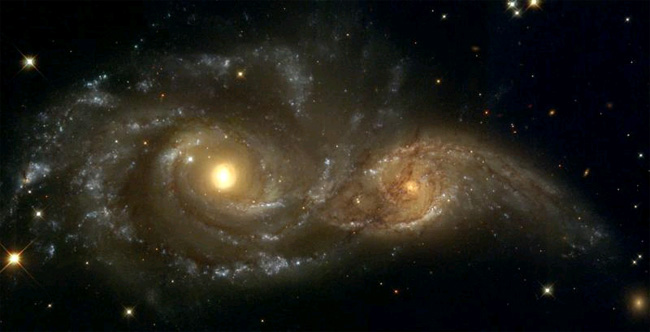
Our solar system might get booted from the suburbs to the boondocks of our galaxy when the Milky Way merges with its neighbor Andromeda in a few billion years, scientists say.
New calculations by T.J. Cox and Avi Loeb of the Harvard-Smithsonian Center for Astrophysics show there is a small possibility that the Sun and its planets will be exiled to the outer reaches of the merged galaxy.
"You could say that we're being sent to a retirement home in the country," Cox said.
Their findings have been submitted for publication to the Monthly Notices of the Royal Astronomical Society.
A galactic dance
Computer simulations by Cox and Loeb suggest the Milky Way and Andromeda will make their first close pass in about 2 billion years. The two galaxies, currently separated by about 2.2 million light-years, are rushing towards each other at about 310,000 mph (500,000 kph). One light-year is equal to about 6 trillion miles (10 trillion kilometers).
During that first close encounter, the two galaxies will circle around each other a few times and their stars will begin to intermingle. The Sun at that time will still be a hydrogen-burning main-sequence star, but it will have brightened and heated enough to boil away the Earth's oceans, other studies predict.
Get the Space.com Newsletter
Breaking space news, the latest updates on rocket launches, skywatching events and more!
The new computer model finds there is a 12 percent chance that during this first brush between Andromeda and the Milky Way, the Sun will be pulled from its present position into a "tidal tail," a streamer-like cluster of orphan stars stripped from their parent galaxies.
After the galaxies circle each other a second time, there is a 3 percent chance our Sun will be more tightly bound to Andromeda than the Milky Way.
"To a certain degree, Andromeda will steal our solar system," Cox told SPACE.com.
''Milkomeda'
In 5 billion years, Andromeda and the Milky Way will have completely merged to form a single, football-shaped elliptical galaxy. Loeb jokingly calls this future galaxy "Milkomeda," but others have also referred to it as "Milkymeda" or the "Andromeda Way."
"It would be cool if it there was a Roman or Greek god that was the last one standing" to name the galaxy after, Cox said.
When the two galaxies finally merge, the Sun will be an aging star on the verge of inflating into a red giant. According to the new computer simulations, the Sun and its planets will get pushed out to 100,000 light-years from the center of the new galaxy-4 times farther than the current 25,000 light-year distance.
The pending merger of Andromeda and the Milky Way has become a part of astronomical lore. The first detailed computer models of the fated crash were made about a decade ago by University of Toronto astronomer John Dubinski.
The new simulation incorporates recent discoveries in galaxy formation as well as the effects of the local landscape of dark matter that surrounds both galaxies, Cox said. The dark matter "actually adds a little bit of drag on the two galaxies and speeds up the merger a bit."
Cox cautions, however, that the new findings should be taken with a large grain of salt. "There are enough uncertainties that it should be regarded more as an exciting possibility than a quantified thing," he said.
- Vote Now: The Strangest Things in Space
- Crash Course: Simulating the Fate of Our Milky Way
- Milky Way vs. Andromeda: Study Settles Which Is More Massive
Join our Space Forums to keep talking space on the latest missions, night sky and more! And if you have a news tip, correction or comment, let us know at: community@space.com.
Ker Than is a science writer and children's book author who joined Space.com as a Staff Writer from 2005 to 2007. Ker covered astronomy and human spaceflight while at Space.com, including space shuttle launches, and has authored three science books for kids about earthquakes, stars and black holes. Ker's work has also appeared in National Geographic, Nature News, New Scientist and Sky & Telescope, among others. He earned a bachelor's degree in biology from UC Irvine and a master's degree in science journalism from New York University. Ker is currently the Director of Science Communications at Stanford University.









